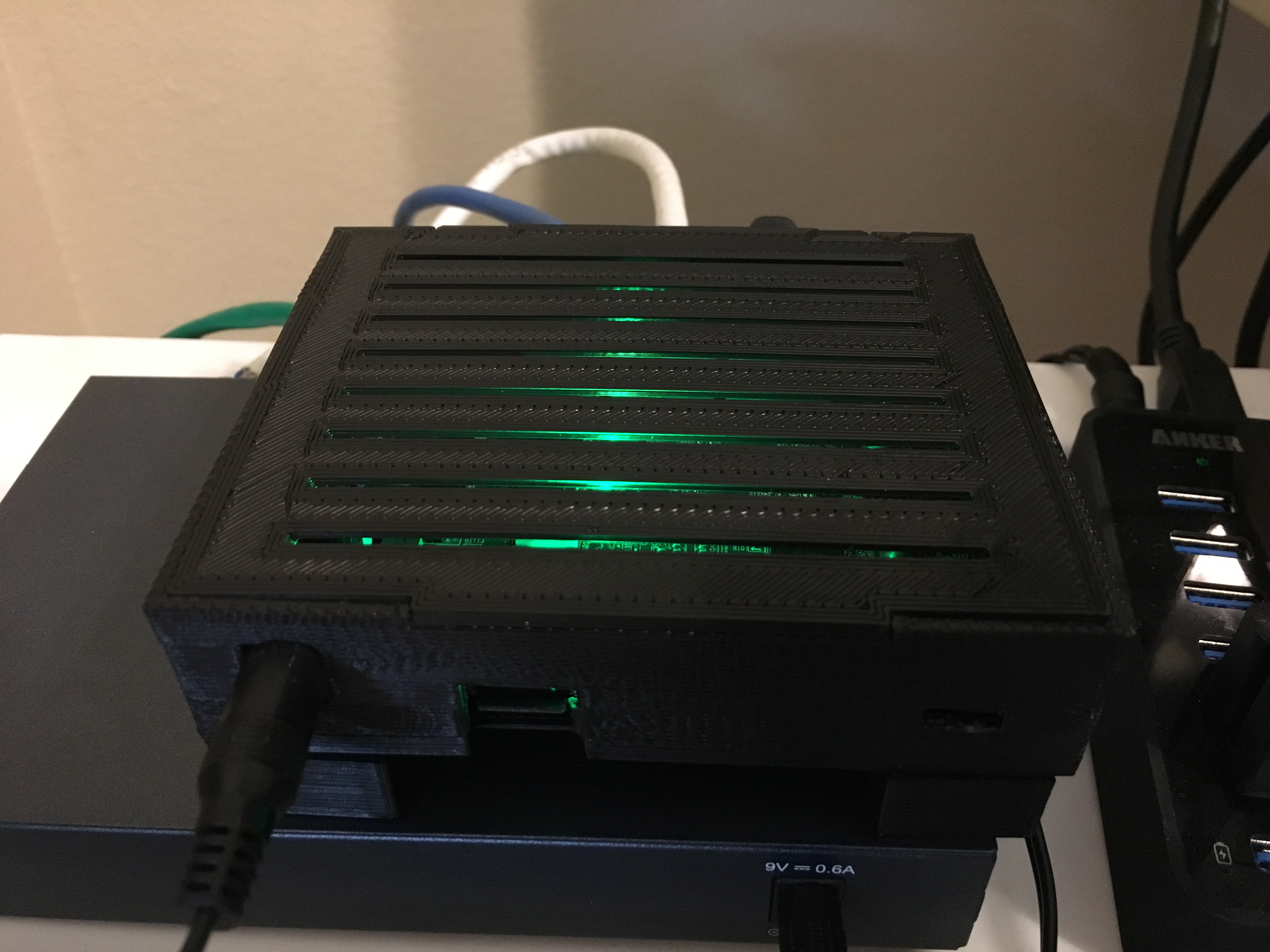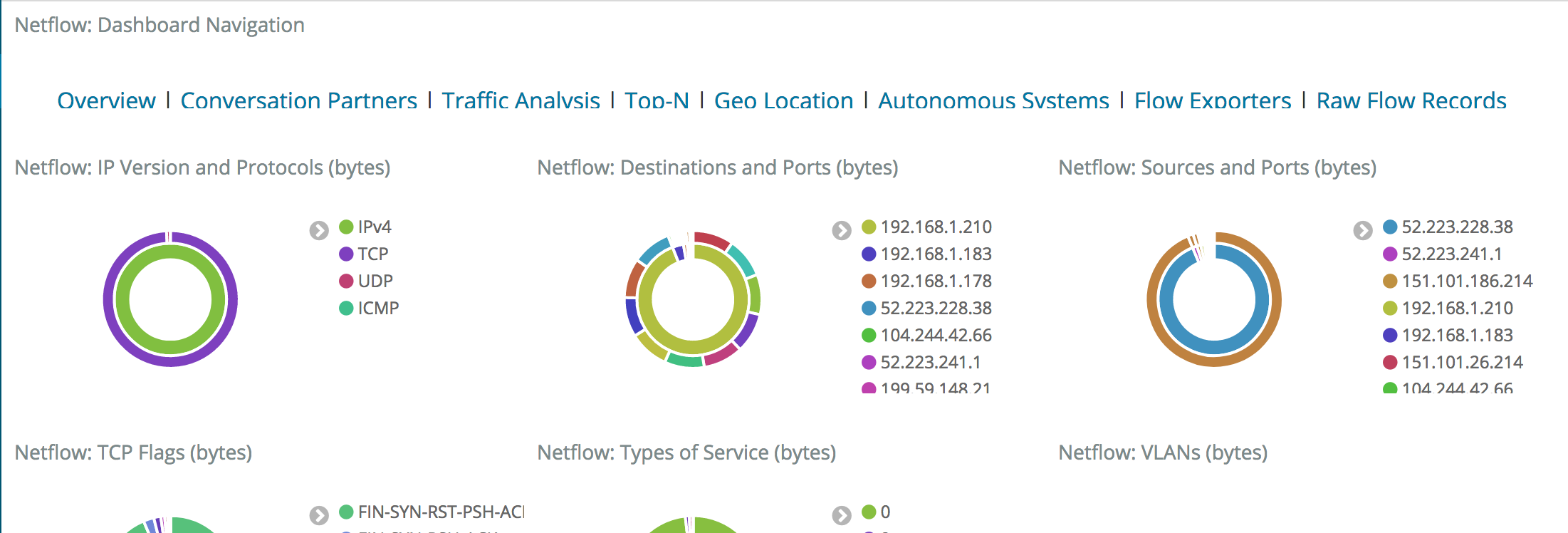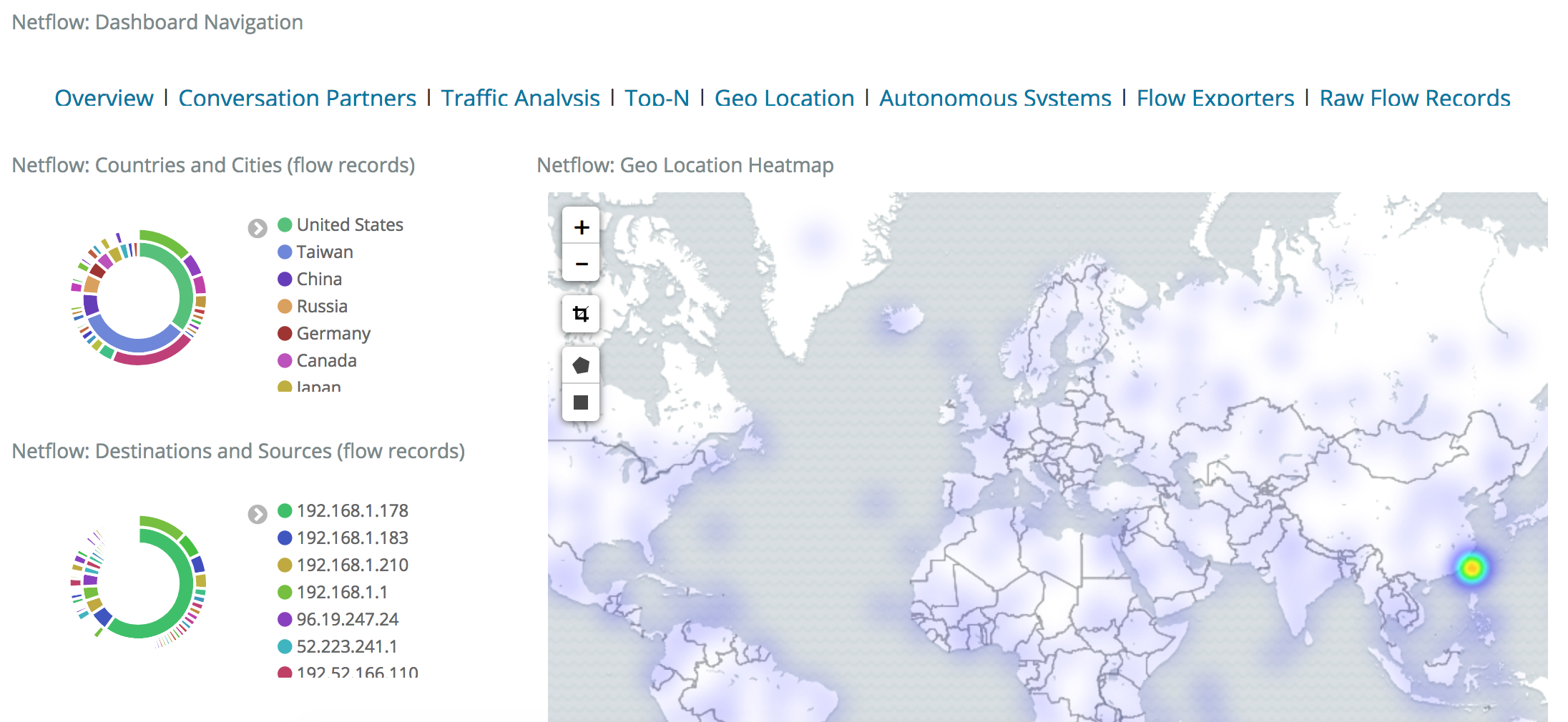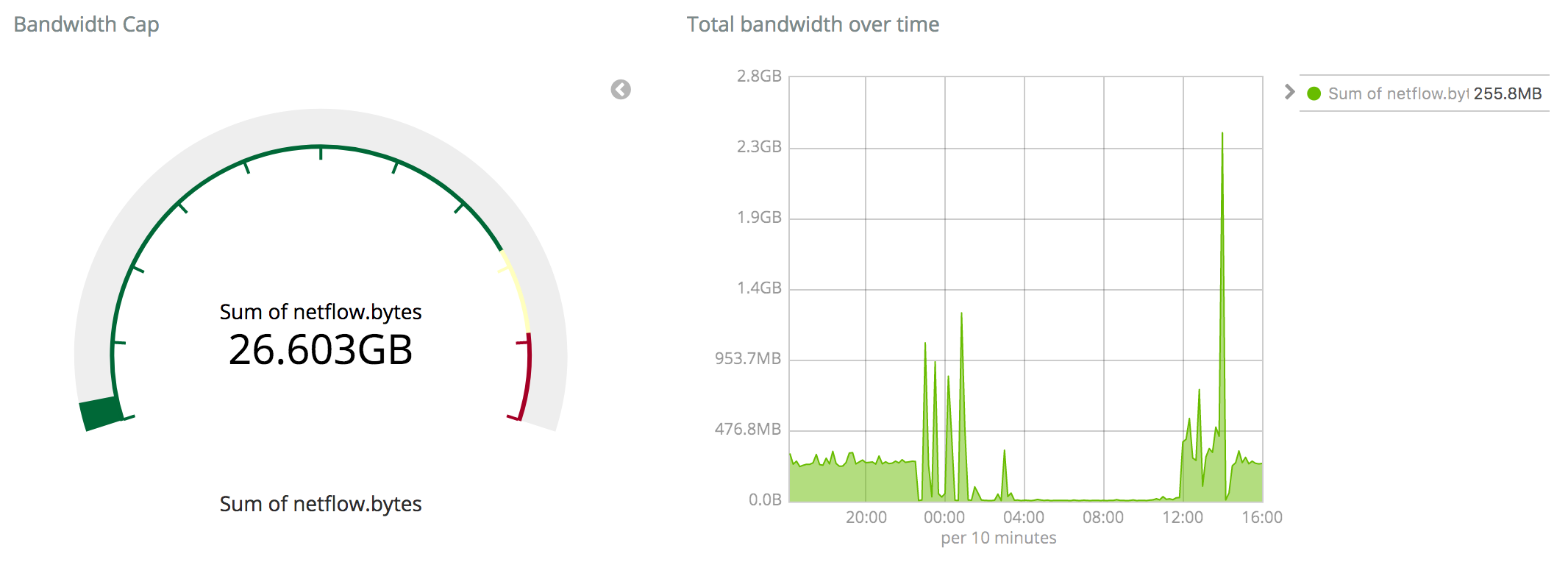After my Asus N66U kicked the bucket, I considered a few options: another all-in-one router, upgrade to something like an EdgeRouter, or brew something custom. When I read the Ars Technica article espousing the virtues of building your own router, that pretty much settled it: DIY it is.
I've got somewhat of a psychological complex when it comes to rolling my own over-engineered solutions, but I did set some general goals: the end result should be cheap, low-power, well-supported by Linux, and extensible. Incidentally, ARM boards fit many of these requirements, and some like the Raspberry Pi have stirred up so much community activity that there's great support for the ARM platform, even though it may feel foreign from x86.
I've managed to cobble together a device that is not only dirt cheap for what it does, but is extremely capable in its own right. If you have any interest in building your own home router, I'll demonstrate here that doing so is not only feasible, but relatively easy to do and offers a huge amount of utility - from traffic shaping, to netflow monitoring, to dynamic DNS.
I built it using the espressobin, Arch Linux Arm, and Shorewall.

Figure 1: My espressoBIN in operation
That picture shows the board enclosed in a 3d-printed case. Unfortunately, the espressobin isn't popular enough to boast a wide variety of purchasable cases as the Raspberry Pi has, but there are some good models out there for 3d printing.
As a side note, the following documentation isn't meant as a comprehensive step-by-step guide to doing the same thing yourself. Although I do want to cover many of the choices that went into the build, configuring something as important as a router/firewall really shouldn't be a copy/paste job and would better be loosely guided by the steps here with a thorough understanding of how and why.
Table of Contents
The Why
There are plenty of solid routers out there you can buy that aren't stock ISP tire fires and would probably be more than suitable (I'm looking at you lovingly, EdgeRouter Lite). So why bother with all of this? There are some legitimate benefits here:
- It's actually very affordable. My router has passed my benchmarks with flying colors, and has every feature I could possibly pull in from Linux (which is a big list).
- It's secure. I feel like a new vulnerability is announced for some consumer network edge device every month. Compare that to a self-managed firewall, and I know exactly which services are exposed (and if iptables is broken, the world has bigger problems). For any naysayers, by the way, the only port listening on my firewall is a random high-numbered port for public-key only ssh authentication. So yes, I do think it's more secure than some Huawei consumer router.
- It has great features. Sure, my espressobin can route and serve as a firewall, but I've dropped in some other useful capabilities as well.
- It's performant. In the minor benchmarks I performed, the espressobin can really push traffic without breaking a sweat.
- It was really fun to build. If you a) need a new router or b) want to cut your teeth on a single-board ARM project, this could be a good fit.
Part One: Hardware
Technically you could put together a router using any computer with two NICs, but we can do equally well with less power, a smaller form factor, and more affordably. ARM boards hit the sweet spot: they're super cheap, more powerful than you'd think, and well-supported with so many variants on the market.
The most well-known contender is the Raspberry Pi, but without two NICs or gigabit networking, it's not a good option. Plus, you're paying for things like a GPU that aren't necessary in a headless network device.
The good news is that last year, the espressobin was released, and it's super capable. It feels purpose-built for this type of thing: gigabit networking, a built-in switch, and no frills that you'd otherwise need for something more general-purpose (there isn't even a display out, just a serial console).
Although the board is fairly young, both Armbian and Arch Linux Arm support the hardware, and both projects do a great job of it. If you haven't explored the world of Linux on ARM, there's not a whole lot to fear here. Armbian and Arch Linux Arm provide everything you need for aarch64 natively in the distribution repos, so there's little that you'll run into that feels foreign on a 64-bit ARM chip, and it certain feels worth it when you factor in the affordability of the hardware and low power footprint.
Here are some of the highlights for me:
- The board includes a builtin Topaz networking switch. In my network testing, traffic that only crosses the LAN interfaces is indistinguishable speed-wise from traffic passing through a vanilla switch. If you stream from a NAS or have otherwise high requirements for inter-device communication that crosses the router, this can make a big difference.
- The serial console is a first-class citizen. On my Raspberry Pis, I sometimes became frustrated having to reach for my HDMI display when debugging issues, but the espressobin has a micro USB serial port for easy console access.
- The aarch64 chip has been great. Not only has it handled everything I've thrown at it, but did you know that it's unaffected by meltdown? The Cortex-A53 chips aren't impacted by the speculative execution bug, so that's an added bonus.
What About WiFi?
I'll make a small note here that I attempted to use the espressobin as a wireless access point as well. The board has a mini PCIe slot well-suited for a wireless card, and although it should have worked, I can definitively report that it's not a good idea.
Without going into painful detail, there's a slew of problems that don't make it worth the effort. I could not get 5Ghz bands working under any scenario, my 2.4Ghz hostapd service became unresponsive every twelve hours or so, and speeds were shockingly bad.
In general, I think this is a failing of the espressobin hardware. Cards that should otherwise be well-supported in Linux (some of the cards I tested were ath9k or ath10k-based) simply don't work with the board's mPCIe interface. Even the officially-recommended cards had problems - the RTL8191SE would work intermittently, and even the card produced by Globalscale doesn't work as advertised. Incidentally, if you find a well-supported card on the espressobin, please do drop a reply on the related forum thread I started to discuss this issue.
With all that being said, my intent at this outset of this project was to separate my AP from my router, whether I ended up using an espressobin or not. Keeping the tasks of firewalling/routing apart from wireless is a nice separation of concerns, and you can get very good dedicated AP devices without any function outside of broadcasting a signal to keep it simple and powerful.
For what it's worth, I ended up purchasing a Ubiquity UniFi device and have been totally happy with it.
Part Two: Software
There are two big choices here: OS and firewalling software.
Operating System
The first choice to make is whether you want to hand-roll this from an distribution that supports aarch64 or use a prebuilt firmware-like solution such as OpenWRT. Personally, I've found that whenever I use a shrink-wrapped solution like Tomato/OpenWrt or FreeNAS for a build, I usually get frustrated without being able to really get in there and tweak things, so I'll be using a general-purpose Linux distribution for the operating system.
As I mentioned previously, Armbian and Arch Linux ARM support the board, and espressobin has official documentation for Ubuntu (as well as Yocto, which I was unfamiliar with until now). While I won't tell you which is best for your use case, here's why I preferred Arch Linux Arm:
- I'm totally sold on rolling release distributions.
- I'm also sold on running atop
bleedingcutting-edge distros. In the case of a router, it's nice to be close to upstream when potentially security-related updates are released. - Arch will provide us with a clean slate to build atop without any extraneous services. This means that, with a minimal base, we can know exactly what we'll have installed, exposed, and running after putting the pieces together.
- I know and like the Arch Linux ARM people. Hi WarheadsSE!
Firewall
Some names like PFSense immediately come to mind, but I'd really like to run something on Linux since I know it much better than a BSD (plus, the best [only?] OS options for the espressobin are Linux-based).
The Linux firewall landscape is pretty broad. Although we'll almost certainly use something iptables-based, there's plenty of higher-level services that sit atop iptables (ufw, firewalld, etc.) While you could write your own simple iptables ruleset and go with it, I opted to use a firewall service since doing so buys us some nice tribal knowledge that the Linux community has fostered over the many years they've managed iptables firewalls.
In general, a good firewalling daemon should:
- Fit in the "healthy OSS project" profile. This means it should be actively maintained, been around for a while, and have decent adoption.
- Avoid complexity. Simple designs are easier to debug, extend, and operate.
- Support some nice-to-have features, such as support for traffic shaping and easy port forwarding configuration.
After poking around for a while, I settled on Shorewall. Here are some of the more noteworthy reasons I went with it:
- The configuration flow is compile-then-apply. This ensures that our ruleset is sane before applying it, which also means that there's no resident daemon consuming the device's resources, which is relevant on a small single-board computer.
- It comes with lots of nice historical knowledge built-in, so the iptables rules that get spit out handle lots of edge cases you wouldn't normally think about.
- I'll cover more of this later, but packet marking and native support for traffic shaping make classful qdiscs easy.
Part Three: The Basic Build
This post isn't meant to be a comprehensive guide, but I wanted to include the broad bullet points so that it's apparent how easy this is to put together.
OS Install
This one is easy - just follow the Arch Linux Arm espressobin page.
It's particularly important to note the added flags on the mkfs.ext4 command and additional U-Boot configuration.
OS Config
Generally, Arch Linux Arm installs are pretty well set from the get-go.
Of course, you'll want to set up a non-root user to administer with that isn't the default account, so remember to disable the alarm user, change all passwords, and update the system.
As a side note, I highly recommend installing the pacmatic package and using it in lieu of regular pacman.
It'll automatically detect updates to configuration files and help merge them, as well as inline important news for breaking package changes.
In addition, I would suggest setting up etckeeper to track your firewall config (the Arch wiki has a good introduction).
I set mine up to automatically push to a privately hosted gitolite repo.
To be completely honest, I dislike every config management solution out there, and almost all of our changes are limited to /etc, so this is good enough backup solution for me at least.
Note that the default network config for the espressobin works well for the router use case:
- Both lan interfaces,
lan0andlan1, are bridged to thebr0interface. This lets us centralize private-network-facing things like dnsmasq on a single virtual interface. - The public-facing interface is
wan. It'll fetch its address from the upstream ISP via DHCP.
The only changes necessary to get br0 and wan setup for our router are two additions: first, assigning the LAN interface a static IP since it'll be the router, and enabling IP forwarding and IP masquerading in /etc/systemd/network/br0.network:
- Font used to highlight constants and labels.
- Font used to highlight keywords.
- Font used to highlight type and class names.
[Network]Address=192.168.1.1/24IPForward=ipv4IPMasquerade=yes
And confirm that the WAN-facing interface will request an address from the ISP in /etc/systemd/network/wan.network:
- Font used to highlight constants and labels.
- Font used to highlight keywords.
- Font used to highlight type and class names.
[Network]DHCP=yesIPForward=ipv4[DHCP]UseDNS=no
I set UseDNS=no here since I prefer to use OpenNIC servers instead of my upstream ISP's - I'll mention where to set these later.
Firewall
The Arch Linux ARM aarch64 repositories have got the latest version of Shorewall, which is what I used. My configs aren't that fancy, and if you're seriously considering deploying Shorewall with a connection to the wild internet, I highly recommend reading the entirety of Shorewall's introduction to a two-interface firewall. It covers the basics of how you should set things up with a nice summary of routing and firewalling in general.
Basically, you'll put the br0 and wan interface into the right zones and set any necessary rules in /etc/shorewall/rules.
Remember to let hosts on your LAN use your DNS server:
DNS(ACCEPT) loc $FW
You'll confirm that DHCP is permitted on the LAN interface in the interfaces file.
I'd note here that I hit a bug with Shorewall during my firewall setup that I found to be patched literally the day before - and Arch Linux ARM had the updated package in the upstream repositories already. Score one point for using up-to-date distros.
DHCP
dnsmasq is the perfect fit for a home router.
It bundles together a DNS and DHCP server into a lightweight daemon that handles everything you'd need from a small network, and it's mature enough that there's plenty of documentation using it for that exact use case.
Note: I attempted to use systemd's built-in DHCP server that you can set with DHCPServer= in .network files, since it seemed like a lightweight way to run a DHCP server without extra software.
Without being too verbose, it's not worth it, one significant reason being there's no way to find current address leases.
There are lots of options that should be set here, but the most important are:
Conf[Unix]- Font used to highlight variable names.
- Font used to highlight comments.
- Font used to highlight comment delimiters.
# Listen for requests on this interfaceinterface=br0# Address range to draw fromdhcp-range=192.168.1.5,192.168.1.250,255.255.255.0,24h# Default route for clients (the address we used in /etc/systemd/network/br0.network)dhcp-option=option:router,192.168.1.1# Instead of doling out DNS servers from your upstream ISP who may do dumb# things for things like unresolvable names, you can rely on other DNS servers.# These are from OpenNIC.server=192.52.166.110server=66.70.211.246server=69.195.152.204server=158.69.239.167
If you need static assignments or aliases, those are easy to add as well.
Part Four: Interlude
With the espressobin serving DHCP and DNS requests on br0, firewalling via Shorewall, and routing packets between the LAN and WAN, it's a functioning router.
At this point, connecting the WAN port to the ISP upstream and the two lan0/lan1 ports to devices or another switch is all that's necessary.
However, that's just a start. If we really want to consider this a router replacement, there's some genuinely cool things we can do to further beef up its capabilities so it doesn't feel like a downgrade from something like my old Asus N66U.
Part Five: Upgrades
I bolted on the following features to my vanilla espressobin router, which I'll each cover in turn:
- Netflow monitoring
- Traffic shaping
Netflow Monitoring
Traffic visibility is something that I found really valuable with my Asus Merlin firmware to track usage. Netflow is the de facto standard for this sort of thing, and among all the available options, I really like ipt-netflow because it's a native kernel module so there's very little overhead and is very actively maintained.
It turns out that I'm probably the first person to use it on the aarch64 architecture, because I got some help to get it supported on aarch64 chipset. The project's maintainer was (and has been) super responsive to bugfixes, so I haven't had any problems ensuring the module is supported on the latest kernels that the Arch Linux ARM project runs on.
Using it is a matter of installing the ipt-netflow-dkms-git package from the AUR.
It'll build for your kernel because dkms is awesome, and I dropped the following into /etc/modules-load.d/ipt-netflow.conf
ipt_NETFLOW
That'll load it, and you configure it in /etc/modprobe.d/ipt-netflow.conf:
options ipt_NETFLOW destination=$ip:2055 protocol=5
Where $ip is your netflow destination.
Finally, traffic gets captured by flowing into a special iptables target, which can be done directly from shorewall, conveniently.
In /etc/shorewall/start:
run_iptables -I INPUT -j NETFLOWrun_iptables -I FORWARD -j NETFLOWrun_iptables -I OUTPUT -j NETFLOWreturn 0
This directs all packets on the router to first enter the NETFLOW target before anything else, which processes the packets and passes them back to flow through the normal rules that Shorewall sets up.
Of course, ipt-netflow needs a place to send netflow logs to, but that's outside the scope of this post.
In my case, I've got a Logstash instance running on my network with the netflow module running and aggregating events in an Elasticsearch cluster.
This gets me some convenient dashboards and the ability to visualize a wide variety of information about my network.
There's some default dashboards:

Figure 2: Logstash Netflow Overview Dashboard
Including some pretty cool ones, like a Geo-IP dashboard:

Figure 3: Logstash Netflow Geo IP Dashboard
However, the most relevant metric I'm interested in is my total bandwidth usage because I've got an antediluvian ISP that cares about data caps. Fortunately that's easy with the netflow data I'm collecting: we can just ask Elasticsearch to sum some fields and get those metrics easily. The following dashboard has two visualizations:
- The gauge compares the sum over the time period in question against the cap my ISP has set for me, so I can easily see where my current usage lies against the cap.
- The timeseries plots bandwidth in bytes over time in order to see when I'm using that bandwidth.

Figure 4: Custom Netflow Bandwidth Usage Dashboard
Something particularly cool about this setup is that, because we're storing the netflow metrics in Elasticsearch instead of some other datastore or time series database, I can actually focus the queries for these dashboards in order to do things like only sum total bytes for certain CIDR ranges because the underlying storage engine (Lucene) understands IP addresses natively. For example, the following query in Kibana:
NOT (netflow.dst_addr:"192.168.1.0/24" AND netflow.src_addr:"192.168.1.0/24")
Will effectively filter out potentially big hunks of bandwidth that happen between hosts on my LAN, such as streaming between my Kodi host and NAS machine. Cool.
Traffic Shaping
This turned into a pretty massive undertaking that was a fascinating rabbit hole to disappear into. Some stock and most custom router firmwares offer some form of QoS or traffic shaping, so I was hoping to do the same on my custom router in order to protect some of my traffic (like Overwatch) from high latencies.
The world of QoS technology is a fascinating place. While you could rely on some simple schemes like an HTB (hierarchical token bucket) filter, advancements in packet filtering are surprisingly active and there are lots of interesting approaches.
What I eventually settled on was an HFSC (hierarchical fair-service curve) filter. I'll be honest: the math behind it is so out of my league that I had to read several summaries attempting to break it down for normal people, and the best explanation that made sense to me was an excellent gist that I stumbled across from GitHub user eqhmcow that explains the benefits and use of HFSC in practice.
The tl;dr is this: with an HFSC traffic control class, you can very effectively prioritize traffic and achieve a good balance between streams that require high bandwidth and low latencies. It's not a magic bullet – you'll still need to mark what types of traffic are latency-sensitive – but it has worked pretty well for me. Without the rules in place, a Steam or Blizzard Launcher download will kill ping times, while active HFSC rules will gracefully trim those heavy portions of traffic to ensure interactive streams aren't impacted. It's really great!
The aforementioned gist does a good job of laying out how to set up your tc classes from scratch.
However, Shorewall can actually handle classful traffic control natively, so we can set up powerful QoS rules pretty easily.
The following config files are based upon my measured bandwidth speeds, which are about 230 down and 10 up.
The first step is to set the relevant tc classes for each device in the tcdevices file:
cat /etc/shorewall/tcdevices
#INTERFACE 97%_down 90%_up options(set hfsc)wan 224mbit:200kb 9mbit hfscbr0 1000mbit:200kb 1000mbit hfsc
Here the LAN-facing br0 interface gets full gigabit, but the WAN interface wan gets 97% of its down speed and 90% of my available up speed.
The reasoning for these numbers is explained in the gist - we're essentially recreating this ruleset in Shorewall terms.
Next, define how packet marks will map to tc classes in the tcclasses file:
cat /etc/shorewall/tcclasses
#INTERFACE MARK RATE CEIL PRIO OPTIONSwan:10 1 full/2:10ms:1540 full 1 tcp-ackwan:11 3 full/2:10ms:1540 full/2 2 defaultbr0:20 2 full*9/10:10ms:1540 full*9/10 1 tcp-ackbr0:21 3 115mbit:10ms:1540 224mbit 2 default
This'll drop important/interactive traffic into classes that get higher priority.
Of course, we also need to mark the packets that should get that higher priority, which is done in mangle:
cat /etc/shorewall/mangle
# ICMP pingMARK(1-2) 0.0.0.0/0 0.0.0.0/0 icmp echo-requestMARK(1-2) 0.0.0.0/0 0.0.0.0/0 icmp echo-reply# sshMARK(1-2) 0.0.0.0/0 0.0.0.0/0 tcp ssh# Overwatch, Hearthstone, Diablo. 3478-3497 are very general RTP ports.MARK(1-2) 0.0.0.0/0 0.0.0.0/0 tcp,udp bnetgame,blizwow,6113MARK(1-2) 0.0.0.0/0 0.0.0.0/0 udp 3478-3497,5060,5062,6120,6250,12000-64000# Local trafficMARK(1-2) 192.168.1.0/24 192.168.1.0/24
This sets the high-priority marks (1 and 2) that get handled by our tc class.
The example includes ICMP pings, ssh, some Blizzard games, and local traffic.
Reloading shorewall should put these into effect. The end result should permit bulk traffic such as downloads or streams while not adversely affecting interactive traffic latency like ssh, in-game ping times, and so on. My informal tests have confirmed this - note that if you decide to verify this yourself, you may observe latency spikes immediately following an initial burst of bulk traffic, but HFSC steps in quickly to enforce limits to keep latencies low for interactive traffic.
I have a couple sets of benchmarks that show HFSC in action, but here's a tiny example: how ping latency are impacted when iperf is run in the background.

Figure 5: Latency impact with and without HFSC
As you can see, without any traffic control rules in place, bursts of bulk traffic can have pretty negative impacts on interactive traffic sensitive to high latencies. With HFSC, we can avoid those problems.
Conclusion
I've been using my home-brew router for several months now and it seems to work great.
I haven't experienced any mysterious connection drops, speed issues, or hardware problems over the entire period of continuous operation, so I'd consider the build a success.
Upgrades are fine as well; after a normal sudo pacmatic -Syu and reboot the system comes back online with all the iptables rules and other services as expected, so keeping up with the latest kernels and other packages is straightforward.
To summarize:
- For an operations-savvy or technically-minded person, a custom router build is very doable. ARM single board computers make it cheap and convenient to get started.
- OSS solutions for firewalling, traffic shaping, and network monitoring are mature and easy to work with. In particular, finely-aged solutions like Shorewall and dnsmasq are very well-documented and have many years of work put into their documentation and feature set.
- While routing + DNS + DHCP is a slam dunk, OSS WiFi can be hit or miss. Your mileage may vary, but my espressobin just isn't a good access point.
This post is already too long, so I'll close here. If you have comments or questions, please do leave one via the Discourse thread attached to the bottom of this post.